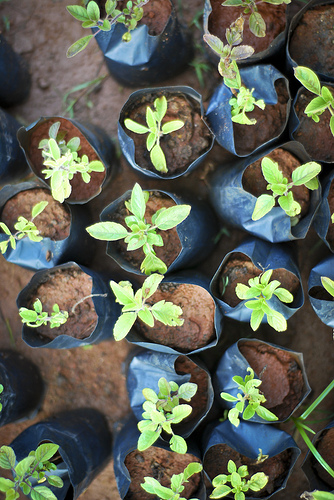Colombia

Share
Related Links
Commercial Reforestation Potential in Colombia
Situación actual y potencial de fomento de plantaciones forestales con fines comerciales en Colombia
Current situation and future potentials of commercial forest plantations in Colombia
External Related Links
Cambio climático tendrá más ayuda internacional
Colombia y Banco Mundial buscarán recursos para mitigar impacto del cambio climático
Colombia y Banco Mundial buscarán recursos para mitigar impacto del cambio climático
Promoting green growth in Colombia: The potential for commercial reforestation
For a forest-rich country, Colombia faces a surprising economic dilemma. More than half of the country is covered by forest, and yet the growing demand for wood products is being supplied by imports – not local industry.
While the construction sector – the largest consumer of wood in Colombia – has grown by an impressive 7 percent between 2005 and 2014, the contribution of the forestry sector to national GDP has actually fallen over this time period, from 1.4 percent to 1.1 percent. Meanwhile, Colombian exports of wood products have stagnated around 3 percent of national production. Based on projections of future demand, this supply gap will only widen: by 2030, Colombian markets will need 4 million m3 more in raw wood materials than it currently produces domestically.[i]
These numbers suggest that Colombia is missing out on a significant investment opportunity, according to a new report commissioned by the Government of Colombia and the World Bank, with support from the Program on Forests (PROFOR).
The study finds that Colombia could not only use its own resources to meet all local demand for wood products, but also supply international markets, which are also on the rise: global demand for timber, pulp and paper products could quadruple by 2050.
Such an expansion would require an ambitious export scenario, where Colombia increases its commercial forest plantations by 464,000 hectares, but is well within the realm of possibility. According to recent land classifications, Colombia has 24.8 million hectares of land suitable for commercial reforestation, of which 30 percent (7.3 million hectares) are considered highly suitable.[1] Eventually, the gross production value of Colombia’s forestry sector could be as high as 12 trillion Colombian Pesos (over 4 billion USD), while creating 35,000 permanent jobs in forest plantations and industries.
“Colombia has broad potential for developing commercial reforestation programs, given its excellent conditions for tree growth, as well as its strategic geographic location for foreign trade and numerous free trade agreements,” said Karin Kemper, World Bank senior director for the Environment and Natural Resources (ENR) Global Practice, at the official launch of the report in Bogotá, Colombia. “This effort would not only have important economic and social impacts by creating jobs and reducing poverty in the countryside, but also play a significant role in mitigation and adaptation to climate change.”
Indeed, commercial reforestation could contribute to Colombia’s pledge of reducing its greenhouse gas emissions by 20-30 percent – a promise that the government takes seriously. "Colombia is committed to policies and tax reforms that help us successfully implement the Paris Agreement, as evidenced by the structural tax reform approved last year," confirmed Minister of Finance Mauricio Cárdenas.
"This report is fundamental in the context of transforming rural areas and the Colombian Government’s Green growth strategy,” said Silvia Calderón, director for environment at Colombia’s National Planning Department, in separate remarks. “Its recommendations will contribute to the sustainable use of natural resources and to the development of the forest economy."
Given Colombia’s high level of political support for green growth policies, what will it take, in practice, to fulfill the potential of the country’s forestry sector? The report lays out detailed recommendations for increasing the productivity of commercial forest plantations and the governance structure around them, as well as improving the competitiveness of Colombian wood processing industries in domestic and international markets.
“By providing very realistic and concrete recommendations, with set targets and timelines, we hope this report can guide the Colombian government in making the most of its exceptional forest resources, while also helping to protect natural forests that might otherwise be threatened by the growing demand for wood products,” said Franka Braun, World Bank senior carbon finance specialist. “Colombia has already expressed interest in commercial reforestation investments in the Orinoquía region, so this initiative is off to a promising start.”
[1] Unidad de Planificación Rural Agropecuaria (UPRA) 2014: Zonificación para plantaciones forestales con fines comerciales a escala 1:100,000, http://www.upra.gov.co/publicaciones/-/asset_publisher/Gcha9Rfz1eZm/content/zonificacion-para-plantaciones-forestales-con-fines-comerciales-colombia-escala-1100-000
[i] As measured in m3 of roundwood equivalents, defined as the volume of small logs typically used in the manufacture of wood-based products like wood pulp, paper, furniture and plywood.
Photo: Santiago Restrepo Calle/Flickr.com
For stories and updates on related activities, follow us on twitter and facebook , or subscribe to our mailing list for regular updates.
Last Updated : 06-16-2024

Commercial Reforestation Potential in Colombia
CHALLENGE
With over 60 million hectares (ha) of natural forests - slightly more than half of the country's land area - Colombia is considered heavily forested. The country's average annual deforestation rate is 280,000 hectares over the last decade (~0.5%). Native forests currently represent the main source of wood and fiber for communities and local industries.
Colombia has enormous potential for developing commercial reforestation programs, for several reasons:
- Excellent conditions for tree growth;
- 17 millions hectares of land potentially suitable for commercial reforestation (World Forest Investment, 2012);
- Geographically well-positioned for exporting forest products, with access along Pacific and Atlantic coasts;
- Increasingly favorable business climate, ranked 5th in terms of “Ease of doing business” (IFC, The World Bank, 2013);
- Growing demand for timber, pulp and paper, which used to be met primarily by natural forests, but it is now recognized that a diverse supply is needed, including through the development of planted forests.
However, commercial forestry in Colombia is still in very early stages of development. Recent estimates indicate that only around 300,000 ha are currently under commercial plantations, which is strikingly low compared to some of its neighbors, such as Chile (2.3 million ha), Argentina (1.4 million ha) and Uruguay (1 million ha). This situation is mainly due to decades of insecurity, which has discouraged development in rural areas and dampened investors’ interests.
Yet, with tremendous progress being made toward the consolidation of peace, this situation is likely to change rapidly. The development of commercial forestry is highly featured on the Government of Colombia's agenda for rural areas, and is identified as one of the pillars for economic growth and employment under the National Development Plan “Prosperidad para Todos 2011-2014.”
APPROACH
This PROFOR activity aims to support the Government of Colombia’s efforts to define the most appropriate model for commercial reforestation, developed in an economically profitable, socially inclusive, and environmentally-friendly way.
This activity was implemented in two phases: The first phase mainly consisted of analytical work targeted on four strategic areas: (i) zoning of the most promising areas for commercial reforestation; (ii) value chain analysis; (iii) institutional and policy framework; and (iv) transportation infrastructure. The second phase consisted of in-depth studies based on outcomes of the diagnosis exercise.
RESULTS
The diagnostic analysis mostly confirmed the anticipated technical issues and the relevance of the four strategic areas. Key elements to be covered under the in-depth studies were discussed with many stakeholders as part of the diagnostic process.
Sustainable reforestation is also receiving more and more attention across Latin America; this work was featured in an article in El País and in a PROFOR blog.
The final study identified a number of key findings, among them:
- Forestry’s total contribution to Colombia's national GDP has dropped, from 1.4% in 2005 to 1.1% in 2014.
- Consumption of wood products has increased steadily, but this has not resulted in an increase of national added value in forestry and primary processing.
- Increased demand for wood products has largely been met by imports, not Colombian industries.
- Colombia's productive commercial plantation area ranges between 340,000 and 360,000 ha.
- A dedicated institutional framework is crucial for the promotion of the commercial plantation sector.
Outcomes from this activity have gained great visibility within the Colombian Government, and are also highly relevant for the World Bank's portfolio. International climate-related financing through the BioCarbon Fund has been made available to Colombia, and the government has confirmed that it would like to target this support in the Orinoquia region, where commercial plantations could be a key element.
For stories and updates on related activities, follow us on twitter and facebook , or subscribe to our mailing list for regular updates.
Last Updated : 06-15-2024








